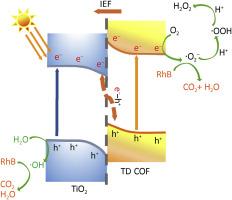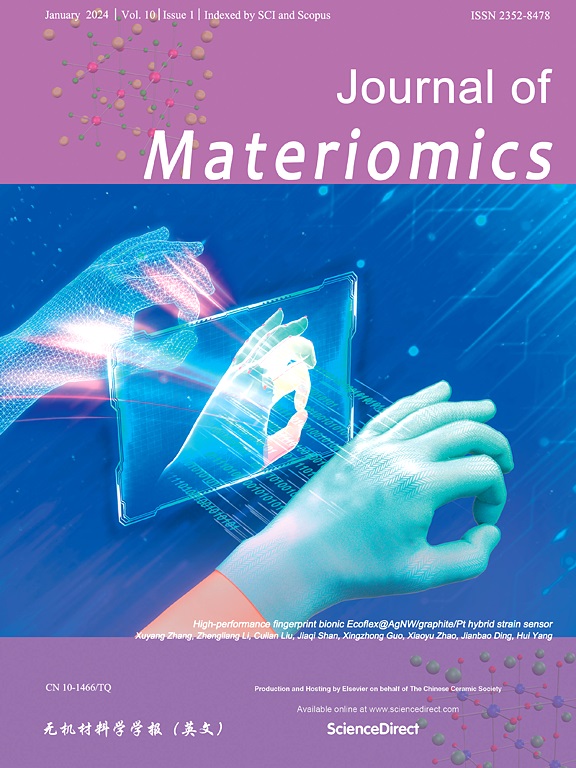Rapid charge transfer in TiO2/COF S-scheme heterojunction for boosting H2O2 photosynthesis and Rhodamine B degradation
IF 8.4
1区 材料科学
Q1 CHEMISTRY, PHYSICAL
引用次数: 0
Abstract
Cooperative coupling of hydrogen peroxide (H2O2) photosynthesis with organic pollutant degradation is promising strategy applied in chemical synthesis and environmental protection. Nonetheless, the photocatalytic performance is limited by sluggish photogenerated carrier separation and limited redox potentials. Herein, an S-scheme heterojunction was constructed by assembling the TiO2 nanoparticles and a Schiff-base COF together. The formed S-scheme TiO2/COF heterojunction can efficiently produce H2O2 and degrade Rhodamine B (RhB) synchronously. The S-scheme charge transfer mechanism in TiO2/COF composite is well unveiled by in situ irradiated X-ray photoelectron spectroscopy and DFT calculation. The femtosecond transient absorption spectra reveal the superior charge migration at interface between TiO2 and COF. The designed TiO2/COF composite shows drastically enhanced H2O2 yield of 1326 μmol·g−1·h−1 in RhB solution, and the AQY value of 4.11% under 420 nm monochromatic light irradiation is achieved. Meanwhile, 100% of RhB degraded under light irradiation for 40 min with TiO2/TD COF as photocatalyst. This work exemplifies a promising approach to design COF-based S-scheme heterojunction with ameliorative photocatalytic performance for simultaneous organic pollutants degradation and H2O2 production.


促进 H2O2 光合作用和罗丹明 B 降解的 TiO2/COF S 型异质结中的快速电荷转移
过氧化氢(H2O2)光合作用与有机污染物降解的合作耦合是一种应用于化学合成和环境保护的前景广阔的策略。然而,光生载流子分离缓慢和有限的氧化还原电位限制了光催化性能。本文通过将二氧化钛纳米颗粒和希夫碱 COF 组装在一起,构建了一种 S 型异质结。所形成的 S 型 TiO2/COF 异质结能高效地同步产生 H2O2 和降解罗丹明 B(RhB)。原位辐照 X 射线光电子能谱和 DFT 计算很好地揭示了 TiO2/COF 复合材料中的 S 型电荷转移机制。飞秒瞬态吸收光谱揭示了 TiO2 和 COF 界面上的电荷迁移。设计的 TiO2/COF 复合材料在 RhB 溶液中的 H2O2 产率大幅提高,达到 1326 μmol-g-1-h-1,在 420 纳米单色光照射下的 AQY 值为 4.11%。同时,以 TiO2/TD COF 为光催化剂,在光照射 40 分钟后,100% 的 RhB 降解。这项工作为设计基于 COF 的 S 型异质结提供了一种具有良好光催化性能的方法,可同时降解有机污染物和产生 H2O2。
本文章由计算机程序翻译,如有差异,请以英文原文为准。
求助全文
约1分钟内获得全文
求助全文
来源期刊

Journal of Materiomics
Materials Science-Metals and Alloys
CiteScore
14.30
自引率
6.40%
发文量
331
审稿时长
37 days
期刊介绍:
The Journal of Materiomics is a peer-reviewed open-access journal that aims to serve as a forum for the continuous dissemination of research within the field of materials science. It particularly emphasizes systematic studies on the relationships between composition, processing, structure, property, and performance of advanced materials. The journal is supported by the Chinese Ceramic Society and is indexed in SCIE and Scopus. It is commonly referred to as J Materiomics.
 求助内容:
求助内容: 应助结果提醒方式:
应助结果提醒方式:


